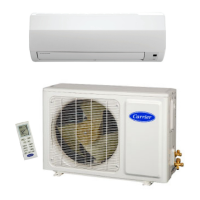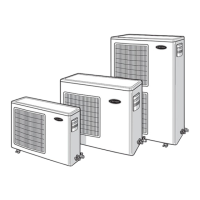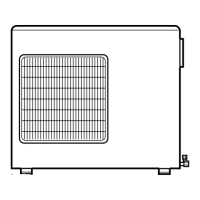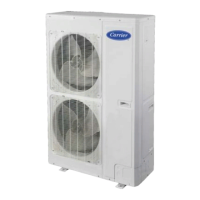Do you have a question about the Carrier 38GVM Series and is the answer not in the manual?
General safety guidelines, signal words, and precautions.
Warning about explosion risk from oxygen mixtures.
Electrical specifications including voltage, current, MCA, and MOCP for outdoor units.
Electrical specifications for indoor units, including power from outdoor unit.
Diagram illustrating the field wiring connections between indoor and outdoor units.
Detailed wiring diagram for the 38GVM 18k model, including component labels.
Diagram illustrating the refrigeration system flow for 18k-30k models.
Diagram illustrating the refrigeration system flow for 36k-42k models.
Procedure for evacuating the system using a deep vacuum method.
Procedure for evacuating the system using the triple evacuation method.
Warning about electrical shock hazard due to capacitors.
Procedure for diagnosing troubles, including error codes and system checks.
Guide for troubleshooting common problems like odor, water noise, mist, and remote control issues.
Diagnostic codes for 18k, 24k, and 30k models and their corresponding error descriptions.
Diagnostic codes for 36k and 42k models and their corresponding error descriptions.
Error codes for sensor malfunctions in units A, B, C, D, and E.
Explanation of LED indicators for various malfunctions and their status (on, off, blink).
Checks for IPM protection malfunction, including voltage, connections, and heat exchangers.
Flowchart for diagnosing compressor wiring connection and winding resistance issues.
Flowchart for diagnosing PFC protection malfunctions related to power supply and reactor.
Flowchart for diagnosing capacity charging malfunctions related to capacitor voltage and reactor.
Flowchart for diagnosing anti-high temperature and overload malfunctions.
Flowchart for diagnosing temperature sensor malfunctions and wiring.
Flowchart for diagnosing start failure malfunctions related to compressor and refrigerant charge.
Flowchart for diagnosing communication malfunctions affecting some indoor units.
Flowchart for diagnosing communication malfunctions affecting all indoor units.
Flowchart for diagnosing compressor overload and discharge protection malfunctions.
Flowchart for diagnosing compressor desynchronizing malfunctions.
General safety guidelines, signal words, and precautions.
Warning about explosion risk from oxygen mixtures.
Electrical specifications including voltage, current, MCA, and MOCP for outdoor units.
Electrical specifications for indoor units, including power from outdoor unit.
Diagram illustrating the field wiring connections between indoor and outdoor units.
Detailed wiring diagram for the 38GVM 18k model, including component labels.
Diagram illustrating the refrigeration system flow for 18k-30k models.
Diagram illustrating the refrigeration system flow for 36k-42k models.
Procedure for evacuating the system using a deep vacuum method.
Procedure for evacuating the system using the triple evacuation method.
Warning about electrical shock hazard due to capacitors.
Procedure for diagnosing troubles, including error codes and system checks.
Guide for troubleshooting common problems like odor, water noise, mist, and remote control issues.
Diagnostic codes for 18k, 24k, and 30k models and their corresponding error descriptions.
Diagnostic codes for 36k and 42k models and their corresponding error descriptions.
Error codes for sensor malfunctions in units A, B, C, D, and E.
Explanation of LED indicators for various malfunctions and their status (on, off, blink).
Checks for IPM protection malfunction, including voltage, connections, and heat exchangers.
Flowchart for diagnosing compressor wiring connection and winding resistance issues.
Flowchart for diagnosing PFC protection malfunctions related to power supply and reactor.
Flowchart for diagnosing capacity charging malfunctions related to capacitor voltage and reactor.
Flowchart for diagnosing anti-high temperature and overload malfunctions.
Flowchart for diagnosing temperature sensor malfunctions and wiring.
Flowchart for diagnosing start failure malfunctions related to compressor and refrigerant charge.
Flowchart for diagnosing communication malfunctions affecting some indoor units.
Flowchart for diagnosing communication malfunctions affecting all indoor units.
Flowchart for diagnosing compressor overload and discharge protection malfunctions.
Flowchart for diagnosing compressor desynchronizing malfunctions.
| Series | 38GVM |
|---|---|
| Cooling Capacity (BTU/h) | 9, 000 - 36, 000 |
| Heating Capacity (BTU/h) | 9, 000 - 36, 000 |
| Refrigerant | R-410A |
| Dimensions (Indoor Unit) | Varies by model |
| Dimensions (Outdoor Unit) | Varies by model |
| Weight (Indoor Unit) | Varies by model |
| Weight (Outdoor Unit) | Varies by model |
| Voltage | 208-230V |












